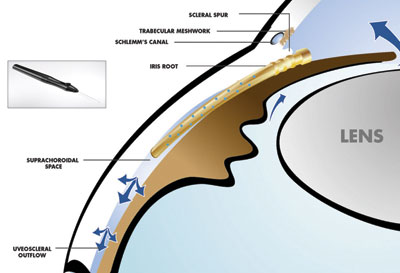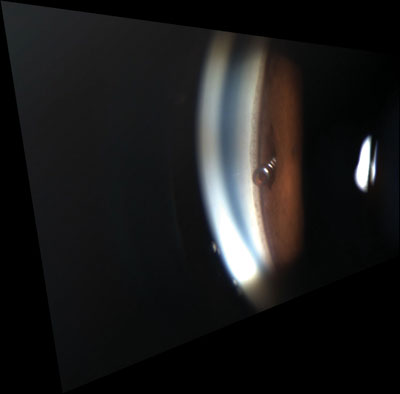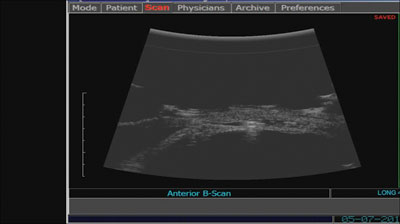Glaucoma micro-device shows stable IOP reduction, good safety profile
The device can be implanted by itself or in combination with cataract surgery.
 E. Randy Craven |
Preliminary results with a micro-device for glaucoma management demonstrate stable pressure reduction and no significant intraoperative or postoperative complications, according to a physician.
“In the past, we used cyclodialysis to stimulate uveoscleral outflow,” E. Randy Craven, MD, said at the annual joint meeting of Ocular Surgery News and the Italian Society of Ophthalmology in Rome. “By separating the ciliary body from the scleral spur, a pathway was opened between the anterior chamber of the eye and the suprachoroidal space, allowing excess fluid to drain. We used an external approach through a large external scleral incision. This procedure frequently led to sudden closure of the cleft and elevated pressure. Hyphema and hypotony were not uncommon.”
The ab interno approach became popular in the 1980s. Full-thickness sclerostomies were performed from within the anterior chamber using holmium, contact YAG or sapphire lasers. A trabecuphine, a small mechanical trephine for tunneling through the angle, could also be used.
At the same time, various types of suprachoroidal shunts were evaluated as an alternative, more stable method of shunting fluid from the anterior chamber to the suprachoroidal space.
“The idea was that an indwelling shunt would maintain patency of the cleft by physically preventing scarring of the surrounding tissue, thus increasing unconventional outflow facility,” Dr. Craven said.
Implanting the device
The CyPass (Transcend Medical) is a biocompatible tubular device with microholes on the surface. It is implanted ab interno in a minimally invasive way into the supraciliary and suprachoroidal space to increase uveoscleral outflow. It can be used as a standalone procedure or in conjunction with cataract surgery.
 The CyPass device after insertion. Inset shows the CyPass Insertion Device. Images: Craven ER |
 CyPass day 1. |
 Access to the choroidal space. High-resolution ultrasound shows the aqueous lake around the shunt. |
A special delivery system is used to insert the implant below the scleral spur at the iris root, through a clear corneal incision or through the primary phacoemulsification incision in combined cataract procedures. The distal end of the device penetrates into the suprachoroidal space, while the proximal collar remains in the anterior chamber. A goniolens is used to visualize the procedure, Dr. Craven said.
“Implantation is carried out under topical anesthesia. With the device in the inserter, you go across the anterior chamber until you visualize the scleral spur and iris root. Once you come up to that position, you gently separate and push away the iris with the inserter and create a small cyclodialysis. Then you push the device off the inserter and follow it as it reaches the suprachoroidal space,” he said.
The CyPass is currently used by a small number of surgeons worldwide. It has obtained the CE mark in Europe.
“In the patients I implanted, no significant intraoperative or postoperative complications were seen. A significant pressure reduction, with consequent reduction of medications, was achieved in most cases,” Dr. Craven said.
Case example
Dr. Craven described the case of a 68-year-old phakic patient who was implanted with the device outside of the U.S. and had IOP in the range of 28 mm Hg on timolol treatment.
The CyPass device was implanted in the patient’s right eye.
“On the first postoperative day, IOP was still quite high, around 26 mm Hg,” Dr. Craven said. “A week out, it had gone down to 17 mm Hg, but was quite rapidly back to 26 mm Hg. The patient was placed on timolol. At 3 months, IOP was 12 mm Hg on timolol. We must remember that it was 28 mm Hg with the same medication preoperatively.”
“I have seen others drop immediately and stay down,” he added.
Dr. Craven said he considers these results encouraging. The CyPass seems to have a good safety profile and leads to IOP reduction, frequently in the lower teens, in the majority of patients.
“This new device holds the advantage of being a minimally invasive procedure. It spares the conjunctiva, it does not lead to a filtering bleb and preserves our ability to have all other future options available,” he said. – by Michela Cimberle

- E. Randy Craven, MD, can be reached at Specialty Eye Care, 11960 Lioness Way, Suite 190, Parker, CO 80134; 303-794-1111; e-mail: ercraven@glaucdocs.com. Dr. Craven is participating in the U.S. trial and has served as a consultant to Transcend. He has implanted the device outside of the U.S.
